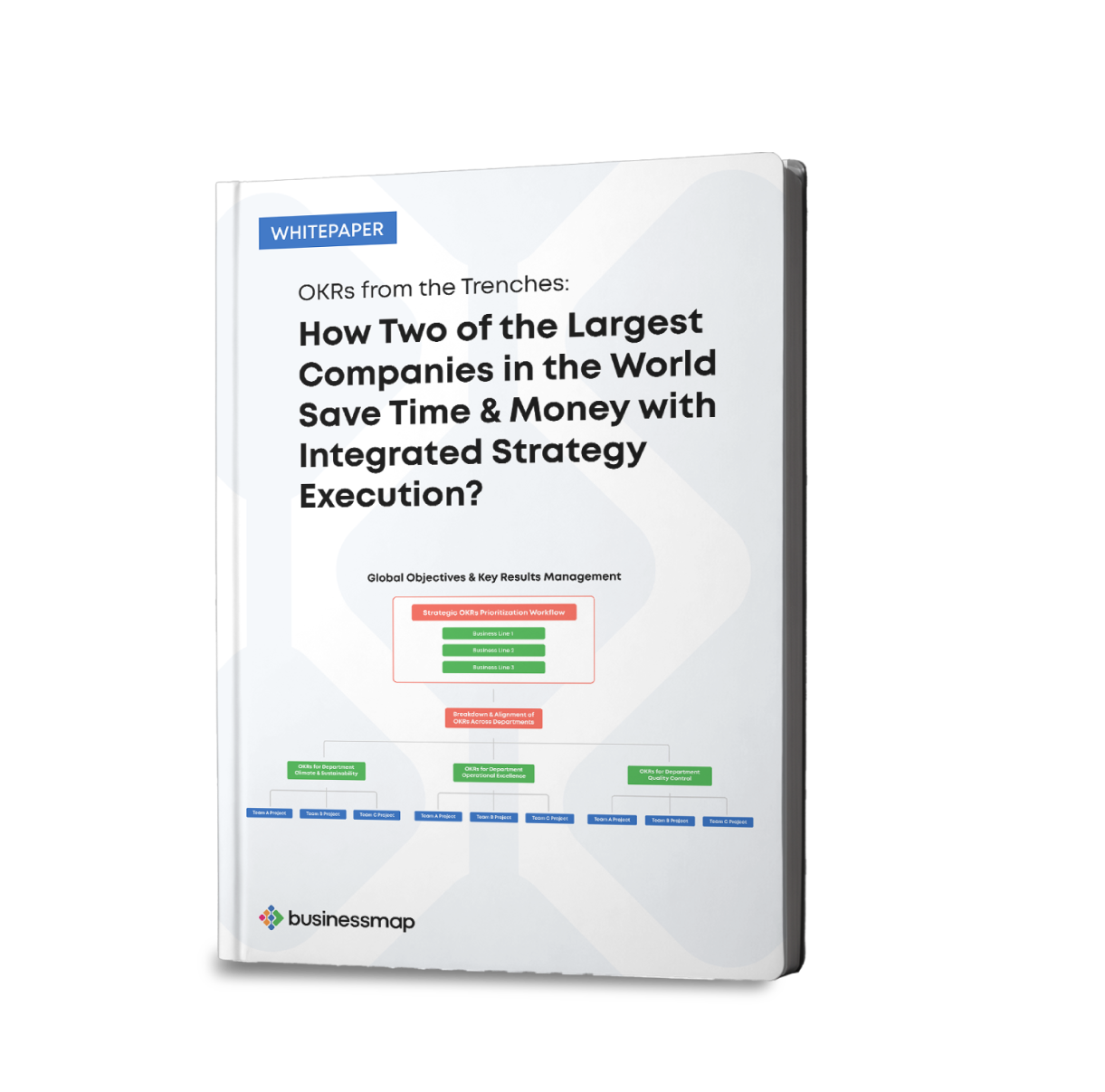You can find a wealth of information about OKRs on the internet, but many individuals and businesses struggle to use them to date correctly. Mastering OKRs is not an overnight process.
Using modern OKR tools gives a good start with OKRs (Objectives and Key Results). However, a comprehensive OKR book is still one of the most effective ways to dig deeper into the framework and understand the philosophy behind OKRs.
You need to have some in-depth knowledge of OKRs to master the art, and some of the best OKR books will help you achieve this. The ten OKR books we have listed in this article explain the concept of OKRs effortlessly.
1. The Beginner’s Guide to OKR
by Felipe Castro One of the greatest resources on OKRs is Felipe Castro's book, "Beginner's Guide to OKRs." It is written for beginners and is one of the best OKR books. It's a great resource to get familiar with OKRs if you don't know much about the model yet.
One of the greatest resources on OKRs is Felipe Castro's book, "Beginner's Guide to OKRs." It is written for beginners and is one of the best OKR books. It's a great resource to get familiar with OKRs if you don't know much about the model yet.
This book consists of 50 pages, making it suitable for first-time OKR users. You will understand better how all of the OKR building blocks fit together as you read it section by section. You will also understand why companies such as Twitter, Google, Airbnb, Spotify, and LinkedIn adopted OKRs.
The OKR book “The Beginner’s Guide” consists of the following parts.
- What is OKR?
- What are the benefits of using OKR?
- Strategic vs. Tactical OKRs: Nested Cadences
- OKRs do not Cascade
- Success criteria and types of Key Results
- How ambitious should your OKRs be?
- Creating Alignment
- Tracking Results with the Weekly Check-in
- A Typical OKR Cycle
- Why you should separate OKR and compensation
- Common OKR mistakes
2. Measure What Matters: How Google, Bono, and the Gates Foundation Rock the World with OKRs
by John Doerr Among the most influential teachers of the Objectives and Key Results (OKRs) methodology, John Doerr is rightfully viewed as one of the most influential preachers. He initially presented the idea of OKRs to the founders of Google.
Among the most influential teachers of the Objectives and Key Results (OKRs) methodology, John Doerr is rightfully viewed as one of the most influential preachers. He initially presented the idea of OKRs to the founders of Google.
OKRs have become a well-known methodology for both established companies and start-ups, thanks to Google's success.
The book "Measure What Matters" reveals the early development and use of the OKR methodology. The book discusses all the ideas and thoughts that came to mind at the time the methodology was first conceived.
In addition, you can read about what is probably one of the most overlooked aspects of goal setting—setting goals alone is not sufficient. You must always keep an eye on them. Your daily activities must be geared towards them.
The OKR book “Measure What Matters” is divided into two parts.
Part 1. OKRs in action. Google, meet OKRs
- The father of OKRs
- Operation crush: an Intel story
- Superpower #1: Focus and commit to priorities
- Focus: the remind story
- Commit: the nuna story
- Superpower #2: Align and connect for teamwork
- Align: the MyFitnessPal story
- Connect: the Intuit story
- Superpower #3: Track for accountability
- Track: the Gates Foundation story
- Superpower #4: Stretch for amazing
- Stretch: The Google Chrome story
- Stretch: The YouTube story
Part 2. The new world of work. Continuous performance management: OKRs and CFRs
- Ditching annual performance reviews: The Adobe story
- Baking better every day: the Zume Pizza story
- Culture
- Culture change: the Lumeris story
- Culture change: Bono's ONE campaign story
- The goals to come.
3. High Output Management
by Andrew Grove The book "High Output Management" is written by the former CEO of Intel - Andy Grove. According to the book, the output of a manager is determined by the output of the team members under their influence.
The book "High Output Management" is written by the former CEO of Intel - Andy Grove. According to the book, the output of a manager is determined by the output of the team members under their influence.
In this book, you'll find actionable insights you can use as a manager which are concise, direct, and to the point. The information is presented in a simple way and with a maximum dose of real-life experience.
The OKR book “High Output Management” is structured in four parts.
Part 1. The breakfast factory
- The basics of production: delivering breakfast
- Managing the breakfast factory
Part 2. Management is a team game
- Managerial leverage
- Meetings: the medium of managerial work
- Decisions, decisions
- Planning: today's actions for tomorrow's output
Part 3. Team of teams
- The breakfast factory goes national
- Hybrid organizations
- Dual reporting
- Modes of control
Part 4. The players
- The sports analogy
- Task-relevant maturity
- Performance appraisal: manager as judge and jury
- Two difficult tasks
- Compensation as task-relevant feedback
How Two of The Largest Organizations in the World Save Time & Money with OKRs?
4. Radical Focus: Achieving Your Most Important Goals with Objectives and Key Results
by Christina R Wodtke and Marty Cagan Through the compelling story of Jack and Hanna's failing tea startup business, the book "Radical Focus" takes a critical look at the OKR framework and the better way to set goals.
Through the compelling story of Jack and Hanna's failing tea startup business, the book "Radical Focus" takes a critical look at the OKR framework and the better way to set goals.
When their sole investor gave the two an ultimatum, they had to learn how to use Objectives and Key Results (OKRs) with radical focus to achieve their objectives.
With the help of Hanna’s experience working with Silicon Valley's hottest companies, the author provides practical tips on achieving goals. By reading Jack and Hanna's story, you'll see that it's about establishing a framework for key results, regular check-ins, and recognizing the value of failure.
The bonus section of Christina Wodtke's book lays out her most practical insights into how to apply OKRs to the challenges you face in your current workplace.
The OKR book “Radical Focus” consists of two parts.
Part 1: The Fundamentals of Objectives and Key Results
- Why Objectives and Key Results Matter
- OKR Coaching Example
Part 2: Objectives and Key Results in Practice
- Implementing OKRs for the First Time
- OKRs for Products
- OKRs for Product Teams
- OKRs and the Annual Review
- Score your OKRs
- Credit Where Credit is Due
5. Objectives and Key Results: Driving Focus, Alignment, and Engagement with OKRs
by Paul R. Niven and Ben Lamorte The book "Objectives and Key Results: Driving Focus, Alignment, and Engagement with OKRs" by Paul Niven and Ben Lamorte is a must-read for managers who want to align their teams with the company's objectives. The book provides practical tools and guidance on creating measurable goals that will help you drive focus, alignment, better communication, transparency, and engagement.
The book "Objectives and Key Results: Driving Focus, Alignment, and Engagement with OKRs" by Paul Niven and Ben Lamorte is a must-read for managers who want to align their teams with the company's objectives. The book provides practical tools and guidance on creating measurable goals that will help you drive focus, alignment, better communication, transparency, and engagement.
The OKR book “Objectives and Key Results” is divided into seven chapters.
- Chapter 1: Introduction to OKRs
- Chapter 2: Preparing for Your OKRs Journey
- Chapter 3: Creating Effective OKRs
- Chapter 4: Connecting OKRs to Drive Alignment
- Chapter 5: Managing with OKRs
- Chapter 6: Making OKRs Sustainable
- Chapter 7: Case Studies in OKRs Use
6. Start Less, Finish More: Building Strategic Agility with Objectives and Key Results
by Dan Montgomery A business strategy can often stagnate or even completely fail to take off when you don't adapt it to market changes and align it to the actual day-to-day activities on the team level. The best way to make your strategy a reality is to keep it flexible. The key is to know where you want to go while remaining open and flexible about how you can get there.
A business strategy can often stagnate or even completely fail to take off when you don't adapt it to market changes and align it to the actual day-to-day activities on the team level. The best way to make your strategy a reality is to keep it flexible. The key is to know where you want to go while remaining open and flexible about how you can get there.
The book "Start Less, Finish More" demonstrates how, through the help of OKRs, you can spend more time doing, reviewing, and adapting your company-wide plan rather than spending a ton of time preparing your strategic plan.
Dan Montgomery breaks down a strategy and OKRs into actionable steps, providing helpful guidance, examples, and frameworks.
The OKR book “Start Less, Finish More” is broken into eight chapters.
- Embracing Uncertainty
- Strategy
- Assess
- Focus
- Commit
- Act
- Learn
- Building the Agile Strategy Management Cycle
7. Succeeding with OKRs in Agile: How to Create & Deliver Objectives & Key Results for Teams
by Allan Kelly The book “Succeeding with OKRs in Agile” is a practical guide on how to use Objectives and Key Results (OKRs) to drive performance in an agile environment. It explains why OKRs are important and then covers how to create, measure, and manage them.
The book “Succeeding with OKRs in Agile” is a practical guide on how to use Objectives and Key Results (OKRs) to drive performance in an agile environment. It explains why OKRs are important and then covers how to create, measure, and manage them.
The author, Allan Kelly, shows how organizations can use OKRs to set goals that align people around what really matters and then take action on those goals every day.
But how do you create and deliver OKRs for teams? This book offers the answer. Reading it, you will learn how to:
- Apply the right tools to build OKR frameworks that work with your Agile process.
- Use OKRs as a tool for everything from team alignment to product development.
- Communicate goals clearly and effectively with stakeholders in your organization.
The OKR book “Succeeding with OKRs in Agile” is divided into five parts with 26 sub-sections.
- I. Why OKRs
- II. Writing OKRs
- III. Working with OKRs
- IV. Leadership
- V. Forewarnings
8. How to Measure Anything
by Douglas W. Hubbard The book "How to Measure Anything" is written by Douglas Hubbard. As he explains in this book, businesses face challenges when setting OKRs, and provide an explanation of how things can be measured to make them safer and more profitable.
The book "How to Measure Anything" is written by Douglas Hubbard. As he explains in this book, businesses face challenges when setting OKRs, and provide an explanation of how things can be measured to make them safer and more profitable.
This book is a step-by-step guide to decomposing a problem, defining what's business-critical, estimating what you intend to measure, measuring just enough, and applying what you've learned.
Douglas Hubbard makes a strong argument that everything is measurable.
“How to Measure Anything” is divided into the following four major parts.
- Measurement: The Solution Exists
- Before You Measure
- Measurement Methods
- Beyond the Basics
9. How Google Works
by Eric Schmidt and Jonathan Rosenberg The book “How Google Works” offers a glimpse into the company that revolutionized the internet and transformed our lives. The author, Eric Schmidt and Jonathan Rosenberg, share insights and advice on how Google made a lasting impact in the world of technological innovation through the adoption of OKRs.
The book “How Google Works” offers a glimpse into the company that revolutionized the internet and transformed our lives. The author, Eric Schmidt and Jonathan Rosenberg, share insights and advice on how Google made a lasting impact in the world of technological innovation through the adoption of OKRs.
The book “How Google Works” is divided into the following eight chapters.
- Introduction - Lessons Learned from the Front Row
- Culture - Believe Your Own Slogans
- Strategy - Your Plan is Wrong
- Talent - Hiring is the Most Important Thing You Do
- Decisions - The True Meaning of Consensus
- Communication - Be a Damn Good Router
- Innovation - Create the Primordial Ooze
- Conclusion - Imagine the Unimaginable
10. The OKRs Field Book: A Step-by-Step Guide for Objectives and Key Results Coaches
by Ben Lamorte The "OKRs Field Book" is suitable for internal coaches, business mentors, and external coaches who are seeking a scalable structure for helping their clients achieve their ambitious goals.
The "OKRs Field Book" is suitable for internal coaches, business mentors, and external coaches who are seeking a scalable structure for helping their clients achieve their ambitious goals.
In this book, the internationally recognized OKRs coach, Ben Lamorte, guides teams through all the phases and steps needed to make their OKRs coaching programs a success.
Each chapter includes real-life examples, insights from his clients, and notes for setting goals and remediating obstacles.
"The OKR Field Book" aims to help mentors and coaches successfully build their own OKRs coaching programs that will propel them towards their ambitious goals.
This OKR book is divided into five chapters.
- Chapter 1: What is OKRs Coaching?
- Chapter 2: The OKRs Coaching Engagement
- Chapter 3: Playbook for Phase 1: Deployment Coaching
- Chapter 4: Playbook for Phase 2: Training
- Chapter 5: Playbook for Phase 3: Cycle Coaching
Businessmap is the most flexible software
to align work with company goals
Related Articles





 One of the greatest resources on OKRs is Felipe Castro's book, "Beginner's Guide to OKRs." It is written for beginners and is one of the best OKR books. It's a great resource to get familiar with OKRs if you don't know much about the model yet.
One of the greatest resources on OKRs is Felipe Castro's book, "Beginner's Guide to OKRs." It is written for beginners and is one of the best OKR books. It's a great resource to get familiar with OKRs if you don't know much about the model yet. Among the most influential teachers of the Objectives and Key Results (
Among the most influential teachers of the Objectives and Key Results ( The book "High Output Management" is written by the former CEO of Intel - Andy Grove. According to the book, the output of a manager is determined by the output of the team members under their influence.
The book "High Output Management" is written by the former CEO of Intel - Andy Grove. According to the book, the output of a manager is determined by the output of the team members under their influence.
 Through the compelling story of Jack and Hanna's failing tea startup business, the book "Radical Focus" takes a critical look at the OKR framework and the better way to set goals.
Through the compelling story of Jack and Hanna's failing tea startup business, the book "Radical Focus" takes a critical look at the OKR framework and the better way to set goals. The book "Objectives and Key Results: Driving Focus, Alignment, and Engagement with OKRs" by Paul Niven and Ben Lamorte is a must-read for managers who want to align their teams with the company's objectives. The book provides practical tools and guidance on creating measurable goals that will help you drive focus, alignment, better communication, transparency, and engagement.
The book "Objectives and Key Results: Driving Focus, Alignment, and Engagement with OKRs" by Paul Niven and Ben Lamorte is a must-read for managers who want to align their teams with the company's objectives. The book provides practical tools and guidance on creating measurable goals that will help you drive focus, alignment, better communication, transparency, and engagement. A business strategy can often stagnate or even completely fail to take off when you don't adapt it to market changes and align it to the actual day-to-day activities on the team level. The best way to make your strategy a reality is to keep it flexible. The key is to know where you want to go while remaining open and flexible about how you can get there.
A business strategy can often stagnate or even completely fail to take off when you don't adapt it to market changes and align it to the actual day-to-day activities on the team level. The best way to make your strategy a reality is to keep it flexible. The key is to know where you want to go while remaining open and flexible about how you can get there. The book “Succeeding with OKRs in Agile” is a practical guide on how to use Objectives and Key Results (OKRs) to drive performance in an agile environment. It explains why OKRs are important and then covers how to create, measure, and manage them.
The book “Succeeding with OKRs in Agile” is a practical guide on how to use Objectives and Key Results (OKRs) to drive performance in an agile environment. It explains why OKRs are important and then covers how to create, measure, and manage them. The book "How to Measure Anything" is written by Douglas Hubbard. As he explains in this book, businesses face challenges when setting OKRs, and provide an explanation of how things can be measured to make them safer and more profitable.
The book "How to Measure Anything" is written by Douglas Hubbard. As he explains in this book, businesses face challenges when setting OKRs, and provide an explanation of how things can be measured to make them safer and more profitable. The book “How Google Works” offers a glimpse into the company that revolutionized the internet and transformed our lives. The author, Eric Schmidt and Jonathan Rosenberg, share insights and advice on how Google made a lasting impact in the world of technological innovation through the adoption of OKRs.
The book “How Google Works” offers a glimpse into the company that revolutionized the internet and transformed our lives. The author, Eric Schmidt and Jonathan Rosenberg, share insights and advice on how Google made a lasting impact in the world of technological innovation through the adoption of OKRs. The "OKRs Field Book" is suitable for internal coaches, business mentors, and external coaches who are seeking a scalable structure for helping their clients achieve their ambitious goals.
The "OKRs Field Book" is suitable for internal coaches, business mentors, and external coaches who are seeking a scalable structure for helping their clients achieve their ambitious goals.

